A fascinating creature, the Dojo Loach is a freshwater nocturnal fish species that loves burrowing and creating tunnels under the substrates. While they’re pretty amusing, they aren’t for everyone, as generic tropical fish care isn’t adequate or ideal for them.
In this article, The tank setup, lifespan, diseases, and other care details of Dojo Loach are discussed via our hands-on experience.
Table of Contents
Dojo Loach Overview
Alluring aquarists with its scavenging and other mysterious abilities, Dojo Loach is native to East Asian countries like China, Korea, Japan, and Taiwan. For centuries, optimally since around 1400 AD, this species of fish has been kept in aquariums and various other artificial waters around the world.
So much so that the species has been tagged to be invasive in many North American river systems.
| Information Chart | Dojo Loach |
| Scientific Name: | Misgurnus anguillicaudatus |
| Family: | Cobitidae |
| Care Level: | Moderate |
| Temperament: | Slightly territorial yet peaceful |
| Color: | Golden-yellow or brown |
| Lifespan: | 8 to 10 years |
| Size: | 6 to 12 inches |
| Diet: | Omnivorous |
| Minimum Tank Size: | 20 gallons for a single Dojo Loach |
| Temperature: | 65 to 77F (18 to 25C) |
| WaterConditions: | pH 6.0 to 7.5 Water hardness: 5 – 15 dGH |
| Tank Mate Compatibility | Community fish with a similar peaceful nature |
Dojo Loach Appearance
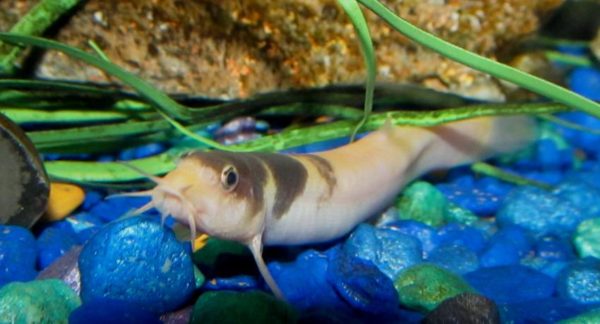
Growing quite large, Dojo Loach has a slim and elongated body with a slightly flattened belly. Towards the tail, the body tapers and gives it an overall cylindrical look.
As for coloration, most Dojo Loaches appear golden-yellow with a few of them hinting towards brown. Their coloration often depends on stress level, choice of substrate, and presence of predators in the tank.
The anal and caudal fins of Dojo loaches significantly lack in size and strength, but the dorsal fin positioned near the back helps it navigate better.
They also don’t have big, tough scales on their body. Instead, thin, small scales and slime covering protect them from external parasites and bacterial infection.
The most distinguishing feature of Dojos is their fleshy barbels around their mouth. The set helps them identify buried food in the substrate through subtle taste buds present on the barbels.
Types of Dojo Loach
There are, primarily, two types of Dojo Loaches that prevail in the wild. One is the regular Dojo Loach with an olive-green body and darker spots.
The other one, the one that’s more popular among hobbyists, is the Golden Dojo Loach. It has a solid golden appearance with random darker spots.
A few other variations, including Albino Dojo, Pink Dojo, or Tiger Dojo also can be considered in this list.
Lifespan of Dojo Loach
The typical lifespan of Dojo Loach is around 8 to 10 years. But it often exceeds with proper care and nutrition. To provide a fulfilling and prolonged lifespan to your Dojo Loach, ensure:
- Water parameters are kept optimum and consistent.
- Water temperature is kept at a lower level than tropical temperatures.
- Despite them being bottom-dwellers, appropriate nutrition is provided.
- A safe environment to practice their natural activities.
Dojo Loach Size
A healthy Dojo Loach, with proper nutrition, can grow up to a massive 12 inches; but they rarely achieve so. Owing to this very reason, they’re advised to be kept in larger tanks.
While the size of Dojo Loach often relies on genetic factors, water parameters, tank size, and other related variables also contribute to the overall outcome.
When growing up, Dojo loaches often try to jump out of the water before and during rainstorms. Make sure to arrange for a proper lid to prevent them from harming themselves.
Natural Habitat
Dojo loaches are pretty hardy fish. They’ve even been found to inhabit streams of Siberia—In winter—thriving. However, their natural habitat comprises moderately thick vegetation, warmer temperatures, and softer substrates like mud and sand.
Their natural burrowing behavior, although protects them from a few natural predators, their sensitivity to weather changes often brings them back to the surface to become prey.
They also can survive natural low-oxygenated and shallower waters by directly gulping air from the atmosphere.
Dojo Loach Care and Tank Set-Up
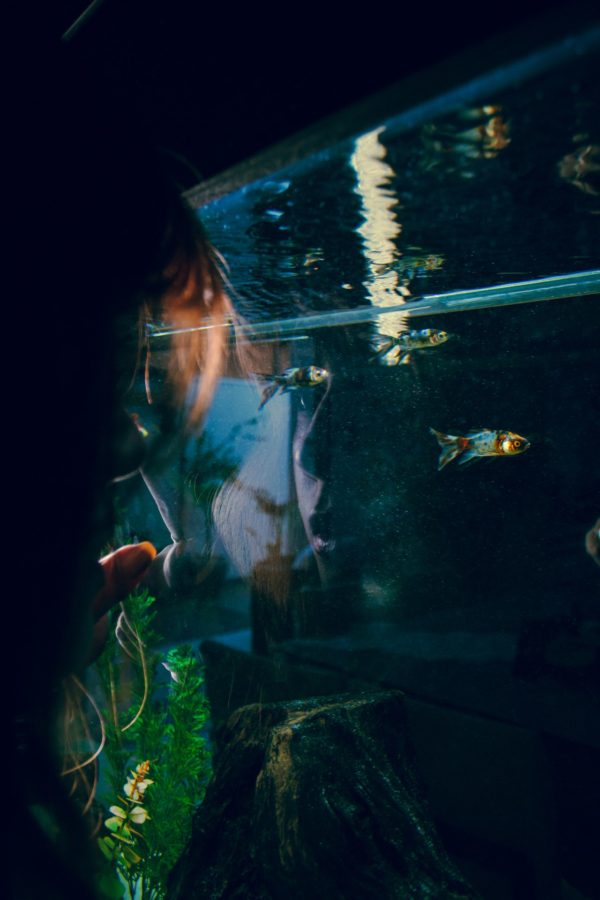
Moving on from extrinsic information, let’s delve into the tank set-up and care requirements of Dojo loaches.
Dojo Loach Tank Size and Specification
Optimum tank size and specification often determine the success and failure of a Dojo loach tank. Despite their tough nature, it’s critical to not abuse them and provide them with an optimum environment.
Optimum Tank Size for Dojo Loach
The optimum tank size for an individual Dojo loach is 20 gallons. In the juvenile phases, they may look like they can be accommodated in 5-gallon tanks, but that’s not what you should do. They grow pretty fast and will outgrow the tank in a few months.
While it’s not necessary, I advise keeping at least 2-3 Dojo loaches together in a bigger tank. If isolated, they can be quite aggressive and develop physiological issues.
Tank Shape for Dojo Loach
A rectangular 20-gallon tank with dimensions of 30” X 12” X 12” is optimum to keep a single Dojo loach. If keeping multiple Dojos, aim for more width and length, as they’re bottom-dwellers and don’t have an extensive height requirement.
Dojo loaches are active swimmers and exhibit erratic swimming habits during rainstorms. Therefore, it’s necessary to provide them with a longer tank.
Filter Type
A substantial amount of bioload is expected from such a bigger fish species. With multiple loaches, the threshold to employ a powerful filtration system lowers even more.
However, Dojos being slender and preferring a moderate water flow, it’s best to employ HOB and sponge filters together to handle the workload. Canister filters may be a bit overkill for a single Dojo loach, but you may consider a flow-adjustable canister filter if you’ve introduced multiple loaches in the tank.
Substrate
As mentioned, soft sandy substrates are pretty well-suited for Dojo loaches for their burrowing behaviors. Gravels may also work if you provide enough hiding space for the Dojos.
However, avoid sharp stones as substrates to prevent harm to the almost-scaleless Dojo loaches.
How many Dojo Loach in a 30 Gallon Tank?
You can keep two adult Dojo loaches in a 30-gallon tank.
Water Parameters for Dojo Loach
This is where we discuss the most critical part of keeping any type of aquarium fish, including Dojo loaches. Regardless of how healthy your fish are or how large your tank is, irregular water parameters can disrupt the balance in a few hours.
Water Temperature
Dojo loaches prefer a water temperature range of 65 – 77 F (18 – 12 C) but they can withstand a lot lower temperatures. The higher temperatures are where they find themselves in trouble.
Here are a few tips to help you cool it down:
- Frequent water changes, even each alternate day, can bring down the heat.
- Use a flow generator to increase water flow and evaporation. It reduces the temperature.
- Keep the tank in the shade. Consider keeping it in air-conditioned places.
- Use floating plants to keep the heat out.
- Use an aquarium chiller to reduce the temperature to a desired level.
Water Flow Rate
This species prefers a low to moderate water flow, where they can actively swim and explore the environment. A lower current also helps the plants to grow stronger roots that may help them fight against the Dojo loaches.
A water flow rate of 400-500 GPH is adequate for Dojo loaches. It’s wise to limit the flow rate to 10X the tank volume. For example, if the tank is 50 gallons, you may increase the flow rate to 500 GPH.
pH Level
A slightly acidic 6.0 to 7.5 pH is preferred by Dojo loaches. Irregular pH levels may cause stress, irritation, and more severe issues. As the Dojos lack prominent scales, abnormal pH can cause fatal physiological issues.
They may also try to jump from the water if the pH levels are not optimum.
To reduce pH,
- Use commercial pH reducers.
- Use RO/DI water while hanging the water.
- Include driftwood and tannin-inducing decorations in the aquarium.
To raise pH,
- Use commercial pH increaser.
- Use crushed corals in the filter.
- Using higher pH tap water carefully.
Water Hardness
Irregular water hardness can cause issues with osmoregulation, gill function, and swimming. Dojo loaches are particularly sensitive to water hardness changes because of their soft skin and heightened sensory capabilities.
Water hardness of 1-12 dH is the acceptable limit for Dojo loaches.
Dojo Loach Tank Landscape
Dojo loaches are curious creatures. They love exploring their environment and hiding beneath the substrate and decorations. Here are the ideal and worst plants for them.
Best Plants for Dojo Loach Tanks
The best plants for Dojo loach tanks include:
- Anubias: Offering both strength and aesthetic appeal, the Anubias plants have thick leaves and strong roots.
- Java Fern: Anchorable to driftwood and rocks, the Java Fern is similar to Anubias in terms of broader leaves and sturdiness.
- Java Moss: Forming carpet-like clamps, the Java Moss is a bright leafy plant that can offer hiding spots for the Dojo loaches.
- Duckweed: The smallest flowering plants known, the Duckweed are single flat oval leaves that float on the surface.
- Cryptocoryne: Found in tropical rivers in Asia, the Cryptocoryne offers durability and hiding space to Dojo loaches with its thick green leaves.
Worst Plants for Dojo Loach Tanks
Very low carpeting plants, such as Dwarf Hairgrass and Glosso are not ideal for Dojo loach tanks as they may get uprooted when challenged by the burrowing activities.
Additionally, stem plants and most floating plants aren’t suitable for Dojo loaches as they often get uprooted or prevent the Dojos from gulping air.
Decorations for Dojo Loach Tanks
Unsurprisingly and similar to eels, Dojo loaches prefer pipes and long hiding spots as decorations. Plants may fulfill the demand to some extent, but here are a few decoration ideas that are perfect for Dojo tanks:
- PVC Pipes
- Terracotta Pots
- Bogwood
- Caves and Tunnels
- Driftwood
- Natural Stone Formations
Lighting for Dojo Loach Tanks
As bottom-dwellers, Dojo loaches have no significant light demands. 1-2 watts per gallon of water is sufficient for these tanks. However, some plants may require you to increase the amount of light.
In contrast, if you have floating plants as we mentioned, they may restrict the lights from reaching under. In that case, you may consider installing a second setting of LED lights.
For fluorescent lights, choose something between 6500 – 7000 K for better Dojo coloration and plant health. But, LEDs are better for Dojo tanks as they produce less heat.
Feeding Dojo Loach
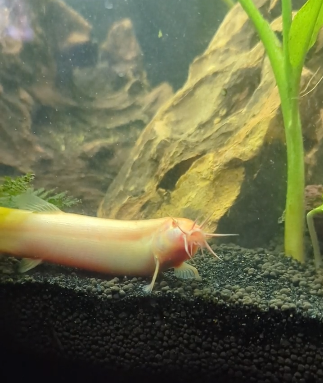
The relatively bigger and messy pooper Dojo loaches, surprisingly, aren’t too picky about what they eat. They gather nutrition from the wasted food and organic particles found in the bottom of the tank.
Best Diet for Dojo Loach
Dojo loaches are omnivorous fish species and enjoy a variety of foods. However, in community tanks, only feed them specialized diets when you’re sure that they aren’t getting proper nutrition through bottom-feeding.
The best diet may include:
- Sinking Pellets: Only feed the ones that are suitable for bottom-feeders,
- Live/Frozen Food: Bloodworms, brine shrimp, and tubifex worms.
- Veggies: Zucchini, peas, and carrots. Don’t make them the main part of the diet.
How often should you feed Dojo Loach?
Feed your dojo loaches 2-3 times a day for 2-3 minutes. Don’t overfeed your fish as it can lead to a water quality drop.
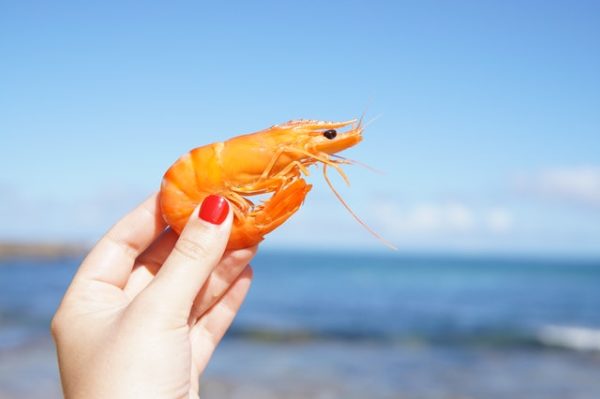
Dojo Loach Behavior and Temperament
I love Dojo loaches. They’re such creatures that you can observe and interact with the whole day. One of our Dojos loves to suck on our fingers (No teeth. They can’t bite) and we adore it for its behaviors, like:
- Weather sensitivity
Dojo loaches are quite weather-sensitive. They can sense the lower atmospheric pressure and erratically swim around the tank.
- Burrowing abilities
They also love to burrow in the sandy substrates to find food, and just because they can.
- Air-breathing
Periodically, the Dojos dart to the surface and gulp air from the surface to extract oxygen via its labyrinth organ.
- Nocturnal behavior
Dojo loaches are primarily nocturnal and exhibit increased activity in the night. Dim moonlighting can help them navigate better.
- Hibernation abilities
Thanks to their ability to extract oxygen from the air, they can survive in moist soil when the surface is freezing over.
- Mystery spawning
No one understands the exact condition of spawning Dojo loaches in captivity. It may be dependent on the migratory behaviors in the wild.
Dojo Loach Tank Mates
This species of loach is quite social and loves chasing and exploring other fish species.
Ideal Dojo Loach Tank Mates
The ideal Dojo loach tank mates are peaceful, non-aggressive, and shouldn’t compete for food. A few examples of such species are:
- Goldfish: Goldfish are coldwater fish compatible with Dojo loaches. They’re peaceful and docile.
- Danios: Danios are a good choice for Dojos as they’re small and active fish, but aren’t aggressive.
- Rasboras: Rasboras are another small, peaceful fish suitable for Dojo loaches.
- Kuhli Loaches: Kuhli loaches don’t compete with Dojos for food.
- Dojo Loaches
- Betta: If given proper space, Betta can be a suitable tank mate for your Dojo loach.
Bad Tank Mates for Dojo Loach
In general, aggressive fish like Oscars, cichlids, and tiger barbs shouldn’t be kept with Dojo loaches.
In addition, very small fish who can’t outswim Dojo loaches can become a part of their diet. Fancy goldfish also are potential bad mates because of their long fins.
Dojo Loach Common Diseases and Their Treatment
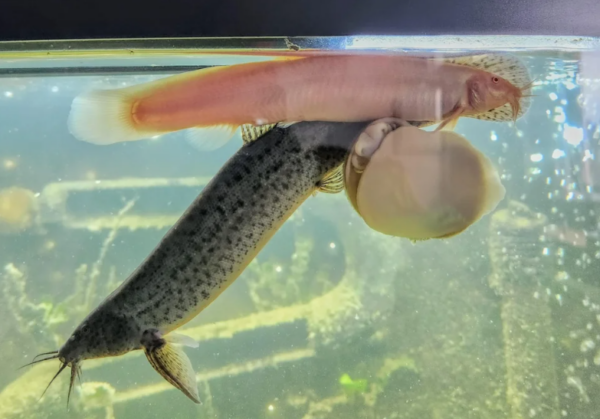
A few common Dojo loach diseases are:
Epistylis
Identified by white, fuzzy growth on the fish’s skin and gills. It often is confused with ich, but epistylis growths are more translucent and have more fatal outcomes. Loss of appetite, lethargy, and breathing difficulty are major symptoms.
Common treatments include isolation, medications, salt baths (not recommended for dojo loaches), and increased water temperature (also not recommended for dojo loaches).
Ich
Similar in appearance to epistylis, ich is a less fatal parasitic infection that causes raised white spots, flashing, and loss of appetite. Breathing difficulty and frequent visits to the surface are the major symptoms of this infection.
Treatments include isolation, medication, and salt baths (not recommended for dojo loaches).
Facts About Dojo Loach
- Dojo loaches are more commonly known as weather loaches/pond loaches.
- Dojo loaches are nocturnal bottom-dwellers.
- Dojo loaches can breathe air through their labyrinth organ.
- Dojo loaches are infamous for their ability to jump.
Are Dojo Loaches right for you?
As a beginner, Dojo loaches are perfect for you. They’re hardy and adaptable fish that can withstand a lack of care and survive misinformation. However, do provide them with a large tank to practice natural behaviors.
The Bottom Line
Hopefully, now you’ll be able to take care of your Dojo loaches more efficiently. Give them a colder temperature, a bigger tank, and hiding spots, and you’ll be actively devoting your whole day to observing them.
